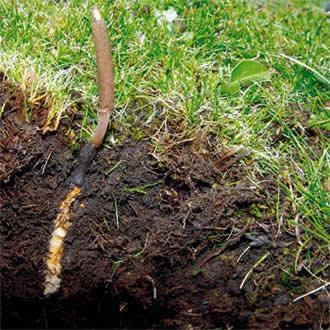Source of Information: Memorial Sloan Kettering Cancer Center, the oldest and largest private cancer center, located in New York, founded in 1884.
Scientific Name: Cordyceps sinensis, Sphaeria sinensis
Common Name: Vegetable caterpillar, Chinese caterpillar fungus, dong chong xia cao, semitake, hsia ts’ao tung ch’ung, yarsha gumb

How It Works
Bottom Line: Cordyceps has not been shown to treat or prevent cancer.
Cordyceps, used in traditional Chinese medicine, contains a fungus that grows on caterpillar larvae; both are contained in the product and both are consumed. Cordyceps has not been studied extensively in the laboratory, but existing studies show that cordyceps stimulates many different immune cells when directly applied to them in a test tube. It is not known if cordyceps stimulates the immune system in humans. Other experiments in animals suggest that cordyceps can stimulate progesterone production and reduce kidney toxicity from harsh medications, but scientists are not sure how cordyceps exerts these effects or if they will occur in humans.
- To lower high cholesterol
No scientific evidence supports this use. - To stimulate the immune system
Laboratory studies show that cordyceps stimulates several aspects of the immune system, but it is not known whether this effect occurs in the human body. - To treat kidney failure
A few studies show that cordyceps may help improve renal function.
- You have a myelogenous type cancer such as AML or CML (Cordyceps has been shown to increase proliferation of red blood cell precursor cells. These cells arise from the same lineage as the cells that cause myelogenous cancers).
- You take insulin or other blood-glucose lowering medications (Cordyceps may have an additive hypoglycemic effect; blood glucose should be monitored).
Cordyceps includes the fungus that grows on the larvae of the caterpillar Hepialus armoricanus Oberthuer. Both are contained in the product and both are consumed. Cordyceps is used for a wide range of conditions including fatigue, sexual dysfunction, coughs, and as an adaptogen or immune stimulant. In vitro and animal studies show antitumor (10) (11) (14), radioprotective (12), and antidiabetic effects (15) (16). In addition, cordyceps enhances recovery of mice with taxol-induced leukopenia (13) and increases the cytotoxicity of cisplatin in non-small cell lung cancer cells (17).
In a recent study cordyceps was shown to improve renal function in patients with chronic allograft nephropathy (CAN) (18).
Although no known drug interactions exist, blood glucose should be monitored in diabetics using cordyceps due to possible hypoglycemic effects.
Animal studies showed proliferation of progenitor red blood cells with cordyceps (8). Therefore, it should not be used by those with myelogenous type cancers.
Cordyceps also stimulated testosterone production in mice (9). Whether it exerts similar effects in humans is not known.
- Bronchitis
- Chronic obstructive pulmonary disorders
- Cough
- Fatigue
- Hepatitis
- High cholesterol
- Immunostimulation
- Sexual dysfunction
- Strength and stamina
- Protein: Amino acids
- Sterols: Ergosterol
- Polyamines: Spermine, spermidine, putrescine, 1,3-diaminopropane
- Fatty acids: Oleic, linoleic, palmitic, stearic acid
- Nucleosides: 3-deoxyadenosine (cordycepin)
- Saccharides: D-mannitol, galactomannin
Cordyceps stimulates the number of T helper cells, prolongs the survival of lymphocytes, enhances TNF-alpha and interleukin 1 production, and increases the activity of natural killer cells in cultured rat Kupffer cells (3). Enhanced proliferation of erythroid progenitor cell in the bone marrow of mice is also shown (8). One study suggests that cordyceps can stimulate progesterone production in animal cells (5). Another study shows that cordyceps may be effective against tumor celIs by down-regulating MHC class II antigen expression (7). In addition, anecdotal data suggest reduction of cyclosporin and aminoglycoside-induced renal toxicity, although the mechanism of action is not known (4).
None reported.
Hypoglycemics / Insulin: Cordyceps may have additive hypoglycemic effect (16) (17).
Purpose of this published study is scientific information and education, it should not be used for diagnosing or treating a health problem or disease. This website is designed for general education and information purposes only and does not substitute for professional medical advice, examination, diagnosis or treatment.
Source of Information: Memorial Sloan Kettering Cancer Center, the oldest and largest private cancer center, located in New York, founded in 1884.
- Huang KC. The Pharmacology of Chinese Herbs, 2nd ed. Boca Raton: CRC Press; 1999.
- Zhu JS, Halpern GM, Jones K. The scientific rediscovery of a precious ancient Chinese herbal regime: Cordyceps sinensis, Part I. J Altern Complement Med 1998;4:289-303.
- Zhu JS, Halpern GM, Jones K. The scientific rediscovery of a precious ancient Chinese herbal regime: Cordyceps sinensis, Part II. J Altern Complement Med 1998;4:429-57.
- Xu F, et al. Amelioration of cyclosporin nephrotoxicity by Cordyceps sinensis in kidney-transplant recipients. Nephrol Dial Transplant 1995;10:142-3.
- Huang B, et al. Cordyceps sinensis and its fractions stimulate MA-10 mouse Leydig tumor cell steroidogenesis. J Androl 2001;22:831-7.
- Nakamura K, et al. Inhibitory effect of Cordyceps sinensis on spontaneous liver metastasis of Lewis lung carcinoma and B16 melanoma cells in syngeneic mice. Jpn J Pharmacol 1999;79:335-41.
- Chiu JH, et al. Cordyceps sinensis increases the expression of major histocompatibility complex class II antigens in human hepatoma cell line HA22T/VGH cells. Am J Chin Med 1998;26:59-70.
- Li, Y. et. al. Effect of Cordyceps sinensis on erythropoiesis in mouse bone marrow. Chin Med J (Engl). 1993 Apr;106(4):313-6.
- Huang YL, Leu SF, Liu BC, et al. In vivo stimulatory effect of Cordyceps sinensis mycelium and its fractions on reproductive functions in male mouse. Life Sci 2004 Jul 16;75(9):1051-62.
- Wu WC, Hsiao JR, Lian YY, et al. The apoptotic effect of cordycepin on human OEC-M1 oral cancer cell line. Cancer Chemother Pharmacol. 2007 Jun;60(1):103-11.
- Oh JY, Baek YM, Kim SW, et al. Apoptosis of human hepatocarcinoma (HepG2) and neuroblastoma (SKN-SH) cells induced by polysaccharides-peptide complexes produced by submerged mycelial culture of an entomopathogenic fungus Cordyceps sphecocephala. J Microbiol Biotechnol. 2008 Mar;18(3):512-9.
- Liu WC, Wang SC, Tsai ML, et al. Protection against radiation-induced bone marrow and intestinal injuries by Cordyceps sinensis, a Chinese herbal medicine. Radiat Res. 2006 Dec;166(6):900-7.
- Liu WC, Chuang WL, Tsai ML, et al. Cordyceps sinensis health supplement enhances recovery from taxol-induced leukopenia. Exp Biol Med (Maywood). 2008 Apr;233(4):447-55.
- Kubo E, Yoshikawa N, Kunitomo M, et al. Inhibitory effect of Cordyceps sinensis on experimental hepatic metastasis of melanoma by suppressing tumor cell invasion. Anticancer Res. 2010 Sep;30(9):3429-33.
- Lo HC, Hsu TH, Tu ST, Lin KC. Anti-hyperglycemic activity of natural and fermented Cordyceps sinensis in rats with diabetes induced by nicotinamide and streptozotocin. Am J Chin Med. 2006;34(5):819-32.
- Shi B, Wang Z, Jin H, et al. Immunoregulatory Cordyceps sinensis increases regulatory T cells to Th17 cell ratio and delays diabetes in NOD mice. Int Immunopharmacol. 2009 May;9(5):582-6.
- Ji NF, Yao LS, Li Y, et al. Polysaccharide of Cordyceps sinensis Enhances Cisplatin Cytotoxicity in Non-Small Cell Lung Cancer H157 Cell Line. Integr Cancer Ther. 2011;10(4):359-67.
- Zhang Z, Wang X, Zhang Y, Ye G. Effect of Cordyceps sinensis on Renal Function of Patients with Chronic Allograft Nephropathy. Urol Int. 2011;86(3):298-301.
